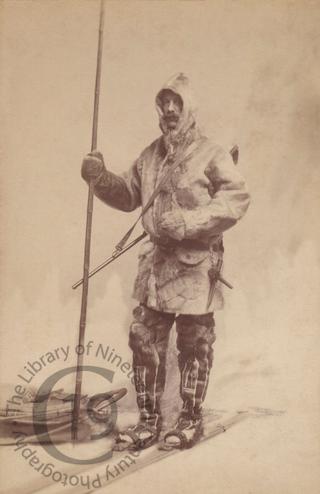
Frederick George Jackson
A cabinet card portrait of polar explorer Frederick George Jackson (1860-1938).
While leading the Jackson-Harmsworth expedition, which was tasked with exploring Franz Josef Land, on 17 June 1896 he and his team met by chance with the Norwegian explorer Fridtjof Nansen and his companion Hjalmar Johansen, who had not been heard of for three years and were presumed dead, but were in fact trying to reach Spitsbergen by kayak.
Frederick George Jackson died on 13 March 1938.
'A British explorer who leaped to fame at the end of the last century with the rescue of the late Dr Nansen, Major Frederick George Jackson, whose adventures ranged from Pole to Tropics, who had blazed new trails in several continents, died yesterday in the barge moored on the Thames near Millbank which for some time had been his home.
'Major Jackson, who was 78, faced the hardships of the explorer's life when nearly 70 with an African expedition which took him to Rhodesia and the Congo forests, where he hunted with the pygmies' (Edinburgh Evening News, 14 March 1938).
'The death of Major Frederick George Jackson, the Artic explorer, occurred on Sunday aboard his sailing barge "Marguerite," moored off Millbank, near Vauxhall Bridge. Major Jackson, who was 78 years of age, had lived on the barge for about a year.
'The eldest son of the late George Frederick Jackson, he was educated at Edinburgh University. As a young man he travelled the Australian deserts and worked on cattle ranches before becoming fascinated by the idea of Arctic exploration. He went to Greenland and obtained such useful expertise in a whaler that in 1893 he offered his services to Dr Fridjof Nansen when the famous "Fram" was being fitted out for a very hazardous trip to the Polar regions. Nansen declined the offer, and Major Jackson determined he would embark on his own. He made from the Kara Sea to Archangel and then journeyed across Lapland in mid-winter.
'Returning to England he decided to organise an expedition to Franz Josef Land which he felt was badly in need of exploration. Shortly afterwards, in 1894, he set out as leader of what was known as the Jackson-Harmsworth expedition. Nansen meanwhile had gone off in the "Fram" to carry out his remarkable attempt to cross the North Polar Basin by taking advantage of a favourable current, which, according to his theory, would enable him to drift in the right direction. Months went by without any news from Nansen and the greatest anxiety was being expressed when a telegram came to the Royal Georgraphical Society in August, 1896, announcing his safe arrival at Varde with Major Jackson. Major Jackson in fact had rescued Nansen after some extraordinary adventures, that subsequently excited the greatest attention and had also added very valuably to knowledge of the polar regions.
'On the outbreak of the South African war Major Jackson volunteered for service, and presently he was commanding a company of mounted infantry. In the last war he went out so quickly that he gained the Mons Star, but subsequently was invalided home. For more than two years he commanded the south-west recruiting district, and in 1919 had charge of Russian prisoner-of-war camps in Germany. In 1925 he went on an African expedition, during which he crossed Portuguese East Africa and Southern and Northern Rhodesia to the Congo border, facing great hardship through heavy floods. Further journeys brought him to the Congo forest, and he hunted for two months with pygmies before descending the whole length of the river Congo to the sea.
'He married in 1929 Mrs Marguerite Wigan Fisher, daughter of the late Albert Hernu, of Boulogne and London. His barge home was named after his wife' (Chelsea News and General Advertiser, 18 March 1938).
Photographed by John Thomson of 70A Grosvenor Street, London.
The photographer's backplate mentions a medal awarded at a Paris exhibition in 1889, so the portrait was probably taken that year or shortly afterwards.
Code: 127799




